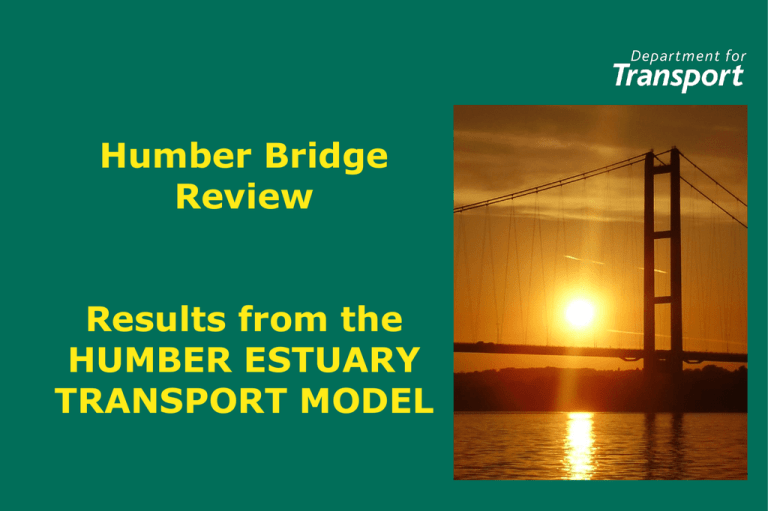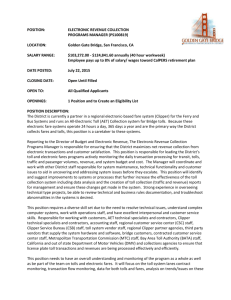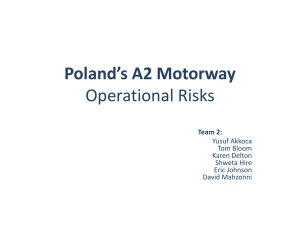Results from the Humber Estuary Transport Model
advertisement

Humber Bridge Review Results from the HUMBER ESTUARY TRANSPORT MODEL This presentation • The model • Results of option tests • Traffic impacts • Economic appraisal Purpose of the model • To allow the assessment of the impact of different tolling scenarios for the Humber Bridge on both: • traffic flows • the Humber area economy • Designed to be consistent with the DfT’s Transport Analysis Guidance (WebTAG) • Designed to forecast the demand response to changes in the tolls in terms of the number & destination of trips made, as well as route choice Model area Full extent: area bounded by Thirsk, Scarborough, Grantham, Boston. Western boundary: A1 >200 traffic origin/ destination zones plus externals Model area Network where all traffic movement actively simulated (links and junctions shown): west of Scunthorpe to east of Hull 150 traffic O/D zones Model capability • 3 time periods: am peak, interpeak, pm peak • 5 vehicle types: private car, 4x goods vehicle classes • 5 passenger journey purposes: • home-based: journey to work, employer’s business, other • non home-based: employer’s business, other • 3 income classes (low, medium, high) for commuting & other • each has its own demand elasticity w/ respect to trip cost • 3 model years: 2010, 2021, 2033 • Does not model public transport Model source data • Update & extension of pre-existing north bank model • 41,000 roadside interviews on trip origin/destination, journey purpose at 38 sites (5,000 interviews at 5 sites bespoke for this study); • >100 traffic count sites • Growth in trips 2010-2033 from DfT National Trip End Model (NTEM) forecast, version 6.2 incorporating the effects of the 2008/09 recession Toll option tests • Base case (Do Nothing) = existing toll level in real terms (£2.70 per car in 2010 prices) • Toll levels tested: • No toll • Maintenance-only level toll, £1 per car (63% reduction, other vehicle classes pro rata) • £2 per car toll (26% reduction) • £2.43 per car toll (10% reduction) Traffic in the base model (2010) Bridge traffic northbound, am peak Bridge traffic southbound, am peak Base case, growth in traffic 2010-2033 Base case, growth in congestion delays 2010-2033 Traffic impact of removing tolls (2010) Impact of reducing tolls by 63% Impact of reducing tolls by 10% Change in congestion delays in zero tolls option (2033 am peak) Modelled effect of toll level on traffic Effect of toll level on bridge traffic (base year), am peak 3,500 3,000 2,500 2,000 1,500 1,000 500 3.00 2.50 2.00 1.50 1.00 Toll (£ at 2010 prices) 0.50 0 0.00 Vehicles per hour, both directions, am peak 4,000 H Bridge (no VDM) H Bridge (with VDM) M62 Goole (no VDM) M62 Goole (with VDM) Modelled effect of toll level on traffic Effect of toll level on bridge traffic (base year), interpeak 2,500 2,000 1,500 1,000 500 3.00 2.50 2.00 1.50 1.00 Toll (£ at 2010 prices) 0.50 0 0.00 Vehicles per hour, both directions, am peak 3,000 H Bridge (no VDM) H Bridge (with VDM) M62 Goole (no VDM) M62 Goole (with VDM) Effect of toll level on traffic, base year (with full demand response) Toll at Change in 2010 prices toll 2.70 Change in traffic am peak Change in traffic interpeak Humber Bg M62 Goole Humber Bg M62 Goole 2.43 -10% 3% 0% 3% 0% 2.00 -26% 10% -1% 10% -1% 1.35 -50% 25% -1% 26% -1% 1.00 -63% 32% -2% 35% -1% 0.00 -100% 54% -2% 67% -5% Economic appraisal • Economic efficiency of the transport system analysis: • For commuters, other consumers, businesses (passenger and road freight), impact on: • travel time • vehicle operating cost • user charges • For the public sector, direct revenues and indirect tax revenues Economic appraisal • Wider impacts analysis: • Agglomeration benefits • Welfare benefits • Broadly speaking, the benefits to employers and employees of a broader, deeper labour pool in a subregional labour market Economic appraisal – transport economic efficiency TUBA benefits by toll level: road freight 120 Road freight - time 100 Road freight VOC Road freight - tolls 80 40 20 0 3 2.5 2 1.5 1 0.5 0 -20 -40 Toll in 2010 (£) PVB £m 60 Economic appraisal – transport economic efficiency Reducing tolls: benefits to users -v- losses to public sector 150 Commuters - tolls Other csrs tolls 100 0 3 2.5 2 1.5 1 0.5 0 -50 -100 -150 -200 -250 -300 Toll in 2010 (£) Present value £m 50 Business psgr - tolls Road freight - tolls Lost revenue Economic appraisal – transport economic efficiency Travel time and vehicle operating costs benefits by toll level Toll in 2010 (£) 2.5 2 1.5 1 0.5 0 5 0 Commuters - travel time -5 -10 Other csrs - travel time -15 Business psgr - travel time Commuters - VOC -20 -25 -30 -35 -40 -45 PVB £m 3 Other csrs - VOC Business psgr - VOC Present value of benefits and costs before wider impacts Present value of costs & benefits by toll level 300 250 150 100 50 £2.50 £2.00 £1.50 £1.00 Toll £0.50 0 £0.00 Present value (£m) 200 PVB pre WITA PVC Present value of benefits and costs before wider impacts 500 450 400 350 300 250 200 150 100 50 0 3 2.5 2 1.5 Toll in 2010 (£) 1 0.5 0 PVB £m Breakdown of WITA benefits by toll level Agglomer ation Welfare Present value of benefits and costs with wider impacts Present value of costs & benefits by toll level 800 700 500 400 300 200 100 £2.50 £2.00 £1.50 £1.00 Toll £0.50 0 £0.00 Present value (£m) 600 PVB pre WITA PVC PVB w ith WITA BCR by toll level BCR by toll level 3.000 2.500 1.500 1.000 0.500 £2.50 £2.00 £1.50 £1.00 Toll £0.50 0.000 £0.00 BCR 2.000 Pre WITA With WITA



